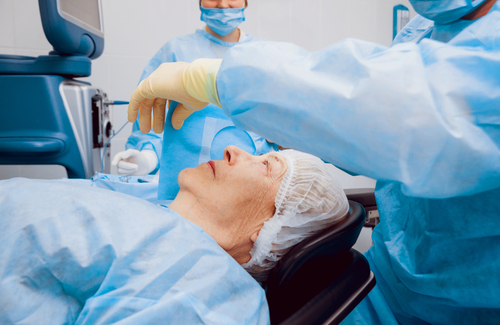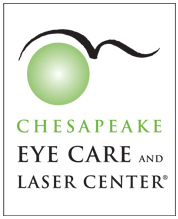What Are the Most Common Cataract Symptoms?
September 7, 2023
Do you feel like your vision is not as clear as it used to be? Are you experiencing visual impairments like night blindness or halos?
If so, you may be experiencing some of the most common symptoms of cataracts. Keep reading to learn more about cataracts, including some of the most common symptoms!
What are Cataracts?
 Cataracts occur when proteins and fibers within the eye break down and clump together, clouding the usually clear and transparent natural lens of the eye. As a result, light cannot pass through the lens to reach the retina, affecting the ability of the eye to see clearly.
Cataracts occur when proteins and fibers within the eye break down and clump together, clouding the usually clear and transparent natural lens of the eye. As a result, light cannot pass through the lens to reach the retina, affecting the ability of the eye to see clearly.
The clouding caused by cataracts can eventually lead to vision impairment, which, if left untreated, can result in vision loss. In fact, cataracts are the leading cause of partial vision loss in America and the leading cause of blindness worldwide.
Cataracts usually develop slowly, taking years to affect the quality of a person’s vision. Because they develop slowly, cataract surgery is not typically needed right away.
Who is Most at Risk for Cataracts?
While people can develop cataracts at any age, they are most commonly seen in older adults. It is estimated that by the age of seventy-five, more than half of Americans have been diagnosed with some stage of cataracts.
While aging is the most common risk for developing cataracts, other factors can increase your likelihood of developing cataracts. These factors include underlying diseases like diabetes, a history of smoking, and eye injury.
What are the Symptoms of Cataracts?
Symptoms can vary from person to person. However, the most common symptoms of cataracts include:
Clouded, Blurred, or Dimmed Vision
 The most obvious symptoms of cataracts are problems with visual clarity like clouded, blurred, or dimmed vision. Often people with cataracts report that they feel as if they are looking through a dirty or frost-covered window.
The most obvious symptoms of cataracts are problems with visual clarity like clouded, blurred, or dimmed vision. Often people with cataracts report that they feel as if they are looking through a dirty or frost-covered window.
Increased Difficulty Seeing in Low Light or At Night
People with cataracts may have trouble seeing at night or have problems seeing in environments with low or ambient lighting. Night blindness can make driving at night increasingly difficult and even potentially dangerous.
Visual Halos
Cataracts can cause people to see halos around sources of light, particularly at night. The presence of visual halos can diminish the clarity of a person’s vision.
Sensitivity to Bright Lights or Glare
Often, people with cataracts find that they are suddenly sensitive to sources of bright lights and glare like car headlights or sunlight reflected off of the ocean. This is because as cataracts develop, they prevent the eye from effectively adjusting to sudden changes in light intensity.
Changes in Color Perception
Cataracts can affect a person’s ability to accurately perceive colors, making them appear faded. They can also make it difficult to differentiate between shades of the same color.

Double Vision
If a person has cataracts in only one of their eyes, it can cause double vision. When a cataract blocks light in one eye, it can affect the brain’s ability to align visual input.
Frequent Vision Prescription Changes
Some people find that before they are diagnosed with cataracts, they have to make more frequent changes to their vision prescription in order to see clearly. Cataracts can also cause existing vision problems, nearsightedness in particular, to worsen.
Milky White or Yellow Pupils
As cataracts develop and proteins collect on the lens of the eye, it can cause the pupils to appear milky white or yellow. Discoloration of the pupils is most often seen in advanced cases of cataracts.
How are Cataracts Treated?
There are some temporary treatment options for people with cataracts in their earliest stages, but the only permanent way to treat cataracts is with cataract surgery. During cataract surgery, the clouded natural lens of the eye is removed and replaced with an artificial intraocular lens, also known as an IOL.
With advances in technology, cataract surgery is now a safe, low-risk outpatient procedure. Most people have short recovery times and report clearer vision within days of the surgery.
In addition to restoring the clarity of one’s vision, the IOL used to replace the natural lens can also improve the quality of one’s vision. The standard IOL offered is a called a monofocal lens, which both treats cataracts and can restore vision at a single distance, either near or far.
There are also advanced premium IOLs that not only treat cataracts but restore vision at two and even three distances. Certain premium IOLs also come in toric versions to correct astigmatism.
Are Cataracts Preventable?
While cataracts are not preventable and are usually just an evitable part of the aging process, the best way to prevent cataracts from affecting the quality of your vision is by scheduling regular comprehensive eye exams. At an exam, your eye care provider performs specific tests to look for the signs of cataracts and other serious eye conditions.
Experiencing the symptoms of cataracts does not have to mean an end to clear, high-quality vision. Familiarizing yourself with the most common symptoms of cataracts can lead to early diagnosis and result in the best possible cataract treatment outcomes!
Do you think you may be experiencing symptoms of cataracts? Schedule a cataract evaluation at Chesapeake Eye Care & Laser Center in Annapolis, MD, today!



